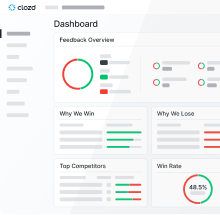Successful B2B organizations know that delivering compelling products isn’t enough—operationalizing a direct line between Customer Experience (CX) and Product Development is essential for staying ahead. But true alignment is never accidental. It requires intentional collaboration, robust feedback systems centered on the voice of the customer, and a culture that commits to acting on real-world insights.
The Importance of Aligning CX and Product Teams
When CX and product teams operate in silos, businesses lose visibility into what customers really need, missing opportunities to improve, innovate, and retain revenue. Aligning these functions ensures that authentic customer feedback directly informs product priorities, driving smarter decisions and tangible business outcomes.
Benefits of Alignment
- Sharper Product-Market Fit: Embedding customer experience feedback in product planning leads to solutions that reflect actual buyer needs.
- Increased Customer Satisfaction: Products developed with real-time, unfiltered buyer input are more intuitive, easier to adopt, and build long-term loyalty.
- Stronger Competitive Advantage: Decisive, cross-functional action on unbiased feedback surfaces differentiators and uncovers blind spots your competitors miss.
- Organizational Alignment: Cross-pollination of insights fosters a growth mindset and accelerates ROI.
Leveraging Customer Feedback for Product Strategy
Customer feedback—when captured authentically and routed efficiently—is how top companies fuel smarter product decisions and maximize revenue impact. But collecting the right feedback, and ensuring it’s actionable, takes more than generic survey data.
Building and Operationalizing a Modern feedback loop
- Integrate Diverse Feedback Channels: Capture feedback at every meaningful touchpoint—live or AI-powered interviews, surveys, and analytics platforms. Industry leaders use Clozd’s solution to automate feedback gathering, scaling high-quality buyer conversations across the entire journey.
- Prioritize Direct Buyer Input Over Internal Assumptions: Clozd’s research shows sellers are wrong about why they win or lose deals 60–85% of the time. Let buyers—not CRM guesswork or internal opinions—steer your roadmap.
- Instant Analysis and Theme Detection: Modern platforms like Clozd use advanced AI to surface decision drivers and actionable insights in seconds, eliminating manual sifting and driving higher ROI.
- Continuous Feedback Routing: Use smart tags and automated workflows to ensure the right teams (CX, Product, Execs) see relevant feedback immediately, closing the loop in real time.
Specific Tips for Effective CX-Product Collaboration
Achieving true alignment requires more than the occasional meeting. To move beyond surface-level cooperation, embed collaboration in daily operations:
1. Co-Design and Own the Feedback Loop
- Secure Executive Sponsorship: Transform collaboration from a grassroots effort into a company priority by getting C-suite buy-in. Programs backed by leadership receive the funding and influence needed to drive change across multiple departments.
- Define Joint Success Metrics: Establish shared KPIs that link customer experience outcomes with product adoption, retention, and win rates. This ensures both teams are accountable to real business results, not vanity metrics.
2. Create Regular, Action-Oriented Syncs
- Hold Monthly Win-Loss Deep Dives: Use structured sessions to review trends from buyer interviews and decide on concrete product actions. Successful organizations (per the Clozd State of Win-Loss Analysis) move quickly—collecting feedback within one month of a deal closing is linked to much higher satisfaction and insight quality.
- Run Cross-Functional Workshops: Bring CX, product, sales, and marketing together to validate pain points, align on priorities, and brainstorm solutions based on unbiased customer input.
3. Democratize Insights Across Teams
- Real-Time Insights Delivery: Push key discoveries directly to product, CX, and execs via channels like Slack, email, or integrated dashboards. The best programs automate alerts each time product-related themes surface, enabling fast reactions and more informed decisions.
- Broadly Share Feedback: Organizations that distribute win-loss findings to most employees see higher win rates, according to Clozd’s 2024 State of Win-Loss Analysis. Make feedback accessible, not locked away in a spreadsheet.
4. Build Feedback into Product Lifecycle
- Embed Buyer Interviews Before Major Milestones: Schedule feedback collection pre-launch, post-implementation, and during roadmap planning sessions.
- Close the Loop with Customers: Share back what’s changing in response to their voice, reinforcing trust and priming for future feedback.
5. Measure and Act on Outcomes
- Track Impact on Win Rates and Churn: Direct feedback-driven changes to features, messaging, or UX should be measurable. Companies that run ongoing, cross-functional feedback programs with Clozd see an 84% chance of increased win rates after two years.
- Spot Hidden Revenue Opportunities: 1 in 10 lost deals can be won back with the right insights. Review feedback to identify which features or gaps are blocking renewals or sales—and act decisively.
Building a Shared Feedback System
A high-impact shared feedback system is the nervous system connecting CX and Product. Here’s a practical playbook for building it:
- Platform Selection: Choose a robust solution—like Clozd—that combines live and AI-powered interviews, survey tools, and real-time analytics.
- Role Definition: Assign clear roles and responsibilities for capturing, analyzing, and actioning feedback. Both CX and product must “own” their piece of the process.
- Automate Participation and Routing: Automate customer outreach and feedback collection so there’s no lag in delivering critical insights to the right people.
- Real-Time, Filterable Dashboards: Use dynamic dashboards where users can filter by product, deal type, segment, or timeline, ensuring relevance and speeding up action.
“The entire leadership team is making use of the data we’re getting from win-loss analysis—not just for sales or product, but also for CSMs, engineering, service and support, and churn analysis. The win-loss insights that are being provided have matured into a holistic understanding of the customer experience.” —Deanna Ballew, SVP of Product at Acquia
Case Study: Aligning CX and Product at a B2B SaaS Company
A B2B SaaS provider specializing in sales enablement transformed their business by fusing CX and product strategies through a unified feedback platform powered by Clozd. This partnership delivered immediate access to deep buyer insights, unlocking priority feature improvements and catapulting sales win rates by more than 50%.
Results Achieved
- Core product enhancements drove a 25% reduction in churn within the first year.
- True cross-functional alignment boosted internal team satisfaction and increased collaboration effectiveness.
- Development cycles shrank, reducing time-to-market for key updates by 30%.
- The leadership team reported greater confidence and speed in strategic decisions.
CX and Product Alignment: Challenges and Solutions
No transformation is without obstacles. Cultural inertia, data silos, and competing priorities stall progress. The most successful organizations address these proactively:
Overcoming Common Barriers
- Cultural Resistance: Start with leadership commitment and communicate wins organization-wide. Make sharing customer feedback part of daily routines.
- Eliminate Data Silos: Adopt systems that centralize all feedback and provide custom access controls so every team taps into the same truth.
- Navigating Priority Conflicts: Implement a rigorous prioritization framework based on quantifiable customer impact, fit with company strategy, and development feasibility.
Collaboration Best Practices
- Encourage ongoing, open dialogue between CX and product stakeholders—don’t let the conversation stop at the quarterly review.
- Run cross-functional workshops at every major product decision point.
- Reward and celebrate improvements that result directly from customer insights—showcasing outcomes builds ongoing buy-in and morale.
- Always provide feedback to the customers who participated, closing the loop and fueling future engagement.
Conclusion: Operationalizing Insights for Competitive Advantage
Bridging CX and product isn’t just operational housekeeping—it’s how B2B organizations turn authentic customer feedback into outsized ROI. When you treat buyer truth as your north star instead of CRM mythology, you transform feedback into revenue, retention, and real product innovation.
The path to alignment is straightforward: invest in modern, AI-powered feedback systems like Clozd, replace assumptions with direct customer input, and make cross-functional collaboration the default—not the exception. The organizations that harness this approach don’t just keep up—they win, consistently and measurably.
Ready to make feedback your competitive edge? Download Clozd’s Definitive Guide to Win-Loss Analysis, try the ROI calculator, or request a demo to see how you can operationalize the voice of your customer across every team.











.svg)


.png)









.svg)

.svg)




